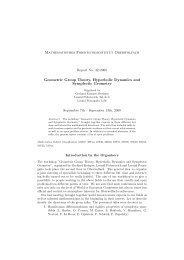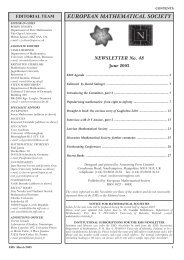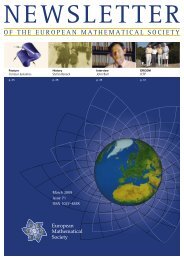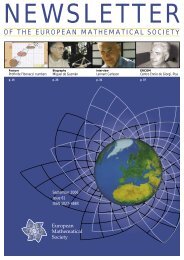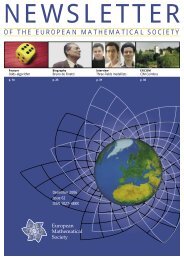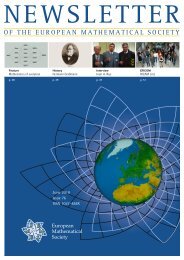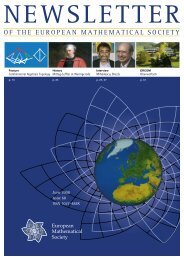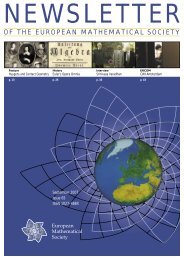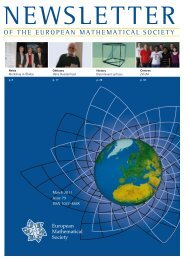Introduction to Teichmüller theory, old and new, II
Introduction to Teichmüller theory, old and new, II
Introduction to Teichmüller theory, old and new, II
You also want an ePaper? Increase the reach of your titles
YUMPU automatically turns print PDFs into web optimized ePapers that Google loves.
<strong>Introduction</strong> <strong>to</strong> <strong>Teichmüller</strong> <strong>theory</strong>, <strong>old</strong> <strong>and</strong> <strong>new</strong>, <strong>II</strong> 3<br />
this action is a compact orbif<strong>old</strong>, known as the Deligne–Mumford stable curve compactification<br />
of moduli space. In 1976, H. Masur obtained a beautiful result stating<br />
that the Weil–Petersson metric on <strong>Teichmüller</strong> space extends <strong>to</strong> a complete metric on<br />
the augmented <strong>Teichmüller</strong> space Tg,n. This result is one of the starting points for a<br />
<strong>to</strong>pological approach <strong>to</strong> the Weil–Petersson metric.<br />
Our knowledge of the Weil–Petersson geometry underwent a profound transformation<br />
at the beginning of 1980s, thanks <strong>to</strong> the work of Scott Wolpert, who obtained a<br />
series of particularly elegant results on the Weil–Petersson metric <strong>and</strong> on its associated<br />
symplectic form. New important results on the subject, from various points of view,<br />
were obtained in the last few years by several authors, including Wolpert, Yamada,<br />
Huang, Liu, Sun, Yau, McMullen, Mirzakhani, Brock, Margalit, Daskalopoulos <strong>and</strong><br />
Wentworth (there are others). The recent work on Weil–Petersson geometry includes<br />
the study of the CAT(0) geometry of augmented <strong>Teichmüller</strong> space, that is, the study<br />
of its nonpositive curvature geometry in the sense of Cartan–Alex<strong>and</strong>rov–Toponogov<br />
(following a terminology introduced by Gromov). We recall that the definition of<br />
a CAT(0) metric space is based on the comparison of distances between points on<br />
the edges of arbitrary triangles in that metric space with distances between corresponding<br />
points on “comparison triangles” in the Euclidean plane. It is known that<br />
augmented <strong>Teichmüller</strong> space, equipped with the extension of the Weil–Petersson metric,<br />
is a complete CAT(0) metric space (a result due <strong>to</strong> Yamada). The Weil–Petersson<br />
isometry group action extends continuously <strong>to</strong> an action on augmented space. The<br />
Weil–Petersson isometry group coincides with the extended mapping class group of<br />
the surface except for some special surfaces (a result of Masur & Wolf, completed<br />
<strong>to</strong> some left-out special cases by Brock & Margalit, which parallels a famous result<br />
by Royden for the <strong>Teichmüller</strong> metric, completed by Earle & Kra). An analysis<br />
of the action of the mapping class group in the spirit of Thurs<strong>to</strong>n’s classification<br />
of mapping classes, showing in particular the existence of invariant Weil–Petersson<br />
geodesics for pseudo-Anosov mapping classes, has been carried out by Daskalopoulos<br />
& Wentworth. Brock established that (augmented) <strong>Teichmüller</strong> space equipped<br />
with the Weil–Petersson metric is quasi-isometric <strong>to</strong> the pants graph of the surface.<br />
In Chapter 1 of this volume, Wolpert makes a review of the recent results on the<br />
metric aspect (as opposed <strong>to</strong> the analytical aspect) of the Weil–Petersson metric. He<br />
reports on a parametrization of augmented <strong>Teichmüller</strong> space using Fenchel–Nielsen<br />
coordinates <strong>and</strong> on a comparison between the Weil–Petersson metric <strong>and</strong> the <strong>Teichmüller</strong><br />
metric in the thin part of <strong>Teichmüller</strong> space, using these coordinates. He gives<br />
formulae for the Hessian <strong>and</strong> for the gradient of the hyperbolic geodesic length functions<br />
<strong>and</strong> for the behaviour of these functions near degenerate hyperbolic surfaces.<br />
He also gives formulae for the Weil–Petersson symplectic form in terms of geodesic<br />
length functions. Weil–Petersson convexity <strong>and</strong> curvature are also reviewed. The<br />
chapter also contains a section on Alex<strong>and</strong>rov angles, in relation with Alex<strong>and</strong>rov tangent<br />
cones at points of the augmented <strong>Teichmüller</strong> space. Wolpert gives estimates on<br />
the exponential map, with applications <strong>to</strong> the first variation formula for the distance<br />
<strong>and</strong> <strong>to</strong> the length-minimizing paths connecting two given points <strong>and</strong> intersecting a




